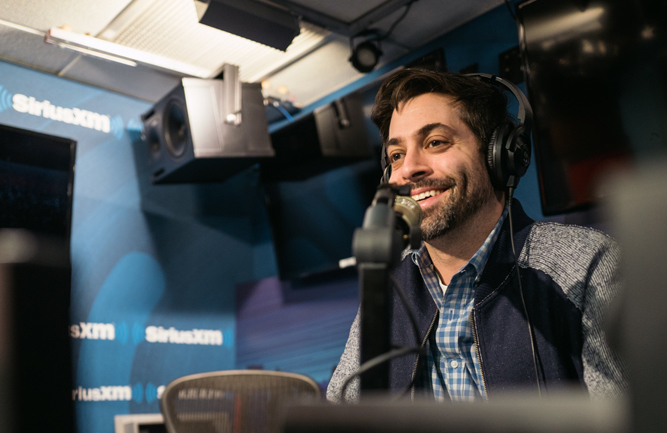Behind the Scene: SiriusXM’s Ari Fink
 Cali Dre
Cali Dre
“When I first got here, I came at it from a music and production perspective, rather than a traditional radio perspective,” Ari Fink says of the decade since he first joined SiriusXM’s New York team. “I learned more about radio as I grew here.”
Fink started his satellite radio career in in 2007 working on the Grateful Dead Channel and, over the following years, he has played a key role on similarly Relix-friendly channels like Jam_ON and Pearl Jam Radio.
The satellite radio service has also nearly quadrupled its subscribers to an estimated 32 million during that time and can be accessed on smartphones and computers as well as in cars and airplanes around the globe.
“We have hosts who can do their shows all around the world at any time of day,” Fink says. “Technology has been updated and we’ve stayed [up-to-date] with it and utilized new tools to be able to create content from anywhere at any time. That’s a really incredible thing.”
When did you get into radio?
I started working at Sirius in 2007. My first job was helping produce digital content for the Grateful Dead Channel. They were in the process of launching that channel and needed someone to process the audio from the Grateful Dead vaults for digital broadcast.
My experiences playing music and editing audio landed me the gig. I’d recorded with my band [ISO], recorded other bands and tinkered in Pro Tools. So working with digital audio was something I was comfortable with. Sirius has a relatively unique presentation when it comes to radio as it is, but they were looking for someone who understood the Grateful Dead catalog and could learn the radio stuff, but knew how to use the technology from the start. I learned more about [how to program for] radio once I got here.
Were you an on-air host at that point?
No, I was just behind the scenes. I didn’t go on the air until 2014. By that point, I had already been Jam_ON’s program director for two years and decided to start jumping on-air. That part of my career is relatively new.
When did you expand your role outside of the Grateful Dead Channel?
Within about a year, I was working on Jam_ON and the Grateful Dead Channel, and I helped out in a supporting role for a handful of years until there was an opportunity to grow within the company. I became the program director of Jam_ON around 2011–2012. And soon after, they asked me to help with the Grateful Dead Channel and pick up programming responsibilities for Pearl Jam Radio.
Can you walk through a typical day for you at Sirius?
Every day is really different. I’ll come in and I will start listening to new music, reviewing some recent live music. We’ll go through upcoming releases and music submissions for a few hours, and tinker with each channel’s database—setting up each day, picking out music for all of our hosts to play and scheduling music. Then, I’ll take some time and write some copy for production, work with our image producers to create all the interstitial audio that airs in between songs, jump into a studio with them to work on that production, and pull clips for interviews or artist appearances. And then a few days a week, in the afternoon, I’ll jump into the studio.
I also spend a lot of time booking artists to come in for sessions. Everything happens all at once, so there’s a lot of multitasking going on.
Jam_ON has also broadcasted live from festivals like Lockn’ and Bonnaroo. What is it like to have an on-site presence at big events like these?
Broadcasting live at festivals is one of the most exciting things that we do. When I first started at Sirius, Howard Stern had been at SiriusXM for less than a year, and the possibility to create audio entertainment from a music perspective was something that really excited me. Festivals are a great representation of that. We get to deliver these in-the-moment experiences as soon as these events happen to people all across the country. Not just at music festivals, but also at concerts. On New Year’s, we were able to broadcast Phish at Madison Square Garden, and we were also able to play some of Widespread Panic’s show at the Fox Theatre in Atlanta and My Morning Jacket’s show in Broomfield, Colo.
So being able to broadcast live events is something that’s super exciting and gives subscribers an opportunity to hear things that they might not be able to catch all the time. I have two small kids, and I don’t get the chance to see as much live music anymore, so it’s a great resource. I’m able to bring up any of the major festivals from any genre because SiriusXM is broadcasting them and I can hear whatever’s going on in that moment. For a live music fanatic, it’s pretty amazing.
How has the industry, and your job, changed from when you started?
SiriusXM has grown an incredible amount since I started. It’s been a really awesome thing to be a part of. There’s a greater opportunity for us to cover such a wide range of events and be involved in so many different things than when I started, which was kind of like, “Hey, if this thing really takes off, it could be a great opportunity to do some new and different things with audio entertainment.”
And it really has gotten to that point. Our operation is massive. We have studios all around the country: LA, Nashville, Orlando, Memphis, Cleveland, and on and on. And people can record remotely—wherever they are, whatever they’re doing.
This article originally appears in the March 2018 issue of Relix. For more features, interviews, album reviews and more, subscribe here.



















